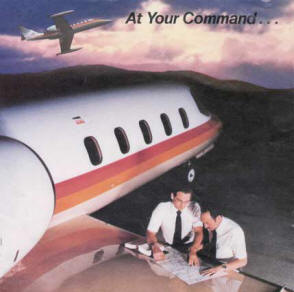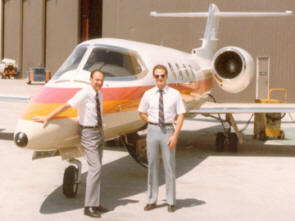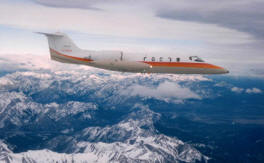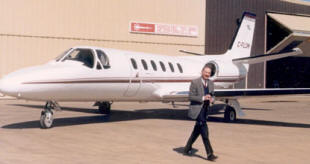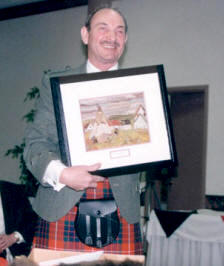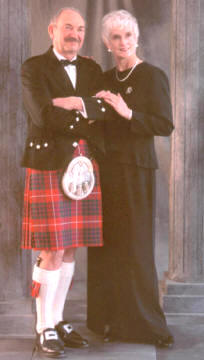| |
| Issue 006/2005 Part ll |
| Part Two and King Airs, small executive jets and turbo-props, respectively. We carried people and/or cargo. On the Lears I had Valery Giscard d’Estaing, ex French head of state, and Hollywood types Burt Reynolds and Kurt Douglas on board at different times, but most of our work was with oil industry or financial people who needed to go a long way quickly. These people used the flight as a traveling office and worked all the way. It was not uncommon to depart Calgary, see the Atlantic and the Pacific and be back in Calgary in the evening. We also saw the Gulf of Mexico and the Arctic ocean in one day.
My son is also a pilot. He worked for Business Flights for a while and we often crewed together on the Lears. Very satisfying. One day I got to do a roll in a Lear. I was training one of our young guys and we were doing practise stalls. This involved pulling the aircraft’s nose up slowly and continuously as the speed dropped until the stall occurred, and then recovering. On this occasion he pulled a bit too sharply approaching stall speed and the aircraft immediately flipped completely upside down. His response was to say, “You have control”. It was kind of fun and I continued the roll right around. You are only supposed to do those in the simulator but this showed the sim really was just like the aircraft. The Lear 35 was not a long range aircraft but we were always trying to make it one. By careful altitude and engine management you could extend the range quite a bit. One day when just level at our initial cruising altitude out of Chatham, New Brunswick, our initial calculations showed dry tanks over Calgary. By getting air traffic control to route us direct to Calgary and letting us climb slowly, and by using careful long range power settings we got our passengers home without stopping and landed with an hour’s fuel remaining. An interesting trip was one we did for the University of Calgary. A professor of Astronomy and his doctoral student there had borrowed a very precision polished window from NASA. We installed it in a Lear along with a rig the prof had built to fit the Lear so as to record light coming through that window. One of our Lear engineers and I went with Bob Edwards to Australia while the prof and student flew out commercial. Our route was Calgary, the Aleutian Islands, Midway, Ponape, Darwin. It was the engineer’s first time across the equator so we doused him with a glass of water at zero degrees latitude. We stayed over night at Ponape, a self proclaimed south seas island paradise. Trouble was it was the dry season and there was no water to drink. We slept on water beds but had to drink beer. Refuelling there was different. They did not have a nozzle to fit a Lear so they hand held the fuel hose by the tank. There was a three inch diameter jet of fuel squirting through the air about six inches from the end of the hose to our tank. We stood a great distance away but the whole procedure did not seem to bother the locals at all. In the end there was neither the fire nor explosion we were certain was going to happen. Along the northern coast of Australia we were at high altitude in just wispy cloud and got hit by a lightening strike. The noise and sound were scary. After landing the engineer found an entry point on a nav radio antenna and a small exit hole in the tail. He replaced the fried radio and we were back to normal. The purpose of the trip was to record the corona during a complete eclipse of the sun whose path was through the Arafura Sea north of Darwin. It was successful and the doctoral student produced a thick volume that purported to prove there were water molecules in the sun’s corona. The flight home started from Port Moresby in Papua New Guinea. We departed at 0600 on 14 June and came via Kwajalein, Midway, and the Aleutians arriving Calgary at 0400 on 14 June. It’s a date line thing. Who says you can’t turn back the clock?
Business Flights was certified to carry dangerous goods and another trip involved ammunition. Dispatch received a call at noon on a Friday that the Brazilian government needed some tank ammunition delivered from Switzerland to Brazil. These were blank shells that Brazil needed to demonstrate some tanks they were trying to sell. By 2000 local that evening Kris Olejnik and I were on our way to Zurich. After resting we loaded the ammo and departed. Our route was via Tenerife in the Canary Islands, Monrovia, Liberia and Recife, Brazil, to Sao Paulo. On departure from Zurich, France control kept us low at first and it took more long ranging to make Tenerife. Dispatch had began making over flight arrangements as soon as we left Calgary but even though they were expecting us at Monrovia it took some time to clear customs and immigration, refuel and depart. It also took about 1,500 US dollars cash handed out before the last guard stepped out of the way and let us taxi. Coming home Brazil control let us cruise at 49,000 feet northbound from Brasilia to Port of Spain, Trinidad. It was sunny at altitude but cloudy down low and we saw only one small curve of the Amazon river. You cannot have this type of happy career without the strong help of your partner. My wife, Lee, was a good example. She was aware that Duty came first and she always supported me. The move from Winnipeg to Calgary, from Service to civilian, was a good example. I left the Service, the married quarter (PMQ) and the city on three days notice to go on course for two weeks. When I got back to Winnipeg Lee met me at the airport and drove me to Calgary to our new house. While I was away she had cleaned and turned back the PMQ, gone to Calgary to find and buy a Condo, and returned to Winnipeg to get me. This may not be strange to other service wives but I think they are among the most independent of women. Thank goodness for that.
This was a start over situation. The aircraft was being used as a bus to carry employees to and from McMurray, Edmonton and Calgary, while the executives flew commercial. We soon had the company officers flying with us all over North America as they required, and working while on board. The Edmonton – Calgary routes were also flown when the aircraft was available. These routine flights routed through our Mildred Lake plant site where we maintained a gravel runway. We probably had more gravel operations than any other Citation. Our total flight hours grew to over 1,300 per year and we were among the top five Citation users in the world. Shortly after I retired in 1994 the department flew over 1,400 hours in one year and was awarded the Cessna trophy for the most Citation hours in that year. The other pilots in the department were all civilian types and with one exception had never been upside down. We had some interesting training flights. Giving them control in a nose high attitude resulted in zero or negative G with dirt, candies and brief cases on the ceiling. However, they were soon making smooth recoveries from nose up and nose down verticals, handling 110, 120 degree bank angles and I was confident they would be OK any situation.
|

